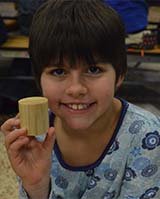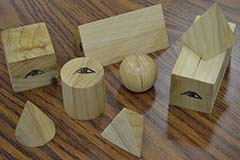Put a bunch of different-shaped wooden blocks in front of kids, and they’re bound to do goofy things with them. Second-grader Dylan Fischer, for instance, put a cone, a pyramid and a rectangle on his head as a kind of hat.
But Kenowa Hills elementary school teachers are counting on a gift of geometric shapes to help Dylan and other students learn math concepts.
Ten sets of eight shapes each came compliments of the Kenowa Hills High School advanced drafting and applied technology and design program. Half a dozen drafting students recently presented Central Elementary teachers with five sets of the shapes they designed and made. Sets also were made for Alpine and Zinser elementary schools.
Sarah Bolthouse, a second-grade teacher at Central, said the shapes will help her students learn about geometry concepts such as edges and vertices, and will tie in nicely with the new Common Core learning standards.
The project emerged from the elementary teachers’ need for new geometry shapes to replace an old set they shared. High school applied technology teacher Mike Johnson offered to have his students fabricate new ones, rather than the teachers having to purchase them.
Johnson’s students went to work to get the shapes ready by Thanksgiving. One student designed them and created paper patterns on a computer program. Others handled the cutting, lathe work, sanding and painting with help from Kenowa Hills Middle School woods teacher Richard Butcher. Students also designed a logo and created packaging.
Hands-on, Literally
A group of the high school students presented the shapes to about 75 Central students gathered in the gym. Junior Alex Florian held up a rectangular prism and other shapes, telling students, “There’s this awesome class where you can make shapes out of wood.”
“Every single one of these shapes is handmade,” Tristen Lobbezoo told the students, who looked impressed.
The Central students then got to see and feel the objects up close. Several gathered around to feel the smoothness of a sphere as Alex Florian described how he shaped it with a belt sander.
 “Showing them how I went through a process is always exciting, because I know they might take that knowledge and use it for something else,” Alex said later.
“Showing them how I went through a process is always exciting, because I know they might take that knowledge and use it for something else,” Alex said later.
He and his classmates said the project helped prepare them for possible careers while helping younger students get the hang of geometry.
“Otherwise, they have to get it out of a book,” said junior Korey Anderson. “Instead they have something right in their hands they can actually see.”
CONNECT








